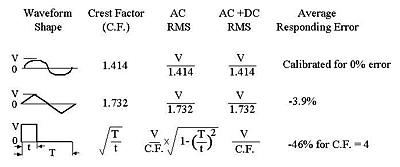Choose a country or area to see content specific to your location
-
PRODUCTS AND SERVICES
-
Oscilloscopes
-
Analyzers
- Spectrum Analyzers (Signal Analyzers)
- Network Analyzers
- Logic Analyzers
- Protocol Analyzers and Exercisers
- Bit Error Ratio Testers
- Noise Figure Analyzers and Noise Sources
- High-Speed Digitizers and Multichannel DAQ Solutions
- AC Power Analyzers
- DC Power Analyzers
- Materials Test Equipment
- Device Current Waveform Analyzers
- Parameter / Device Analyzers and Curve Tracers
-
Meters
-
Generators, Sources, and Power Supplies
-
Software
-
Wireless
-
Modular Instruments
-
Network Test and Security
-
Network Visibility
-
Services
-
Additional Products
- All Products, Software, Services
-
- Learn
- Buy
- Support
- Home
- Resources
- Resources
What are you looking for?
Tip 1: Understand True RMS Measurements

True RMS responding multimeters measure the "heating" potential of an applied voltage. Unlike an "average responding" measurement, a true RMS measurement is used to determine the power dissipated in a resistor. The power is proportional to the square of the measured true RMS voltage, independent of waveshape. An average responding ac multimeter is calibrated to read the same as a true RMS meter for sinewave inputs only. For other waveform shapes, an average responding meter will exhibit substantial errors as shown in the figure to the right.
A multimeter typically uses a dc blocking capacitor to only measure ac component of a signal. Only the "heating value" of the ac components of the input waveform are measured (dc is rejected). For sinewaves, triangle waves, and square waves, the ac and ac+dc values are equal since these waveforms do not contain a dc offset. Non-symmetrical waveforms, such as pulse trains, contain dc voltages, which are rejected by ac-coupled true RMS measurements.
Want even more details on True RMS measurements - Including the different types of technology used to measure RMS voltages and a measurement-troubleshooting guide? See Make Better RMS Measurements with Your DMM (AN 1392)
- © Keysight Technologies 2000–2024
- Privacy
- Sitemap
- Terms
- Trademark Acknowledgements
- Feedback
- Accessibility
